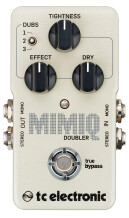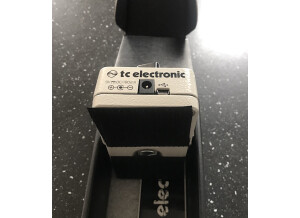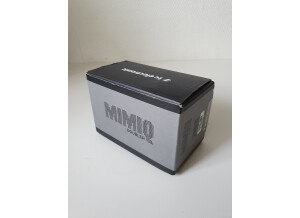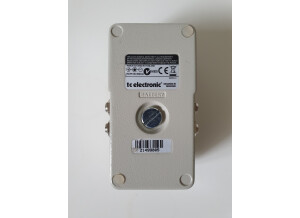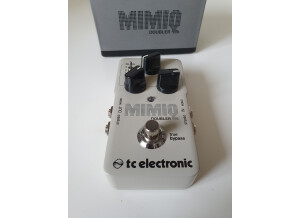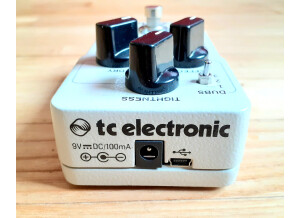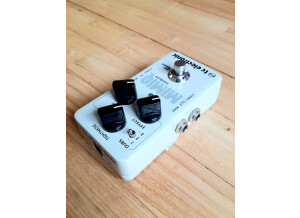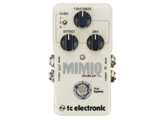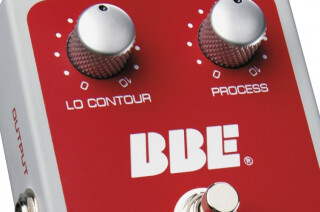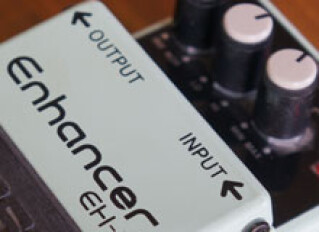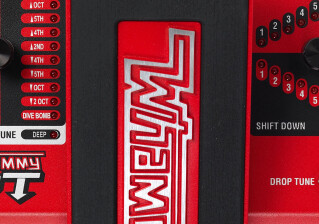Buy new TC Electronic Mimiq Doubler
- Thomann In stock / Delivered in 24h €129.00
- Thomann In stock / Delivered in 24h €146.00
- Thomann In stock / Delivered in 24h €148.00
Mimiq Doubler classified ad
Alerte nouvelle annonceImages
Videos
Reviews
5.0/5(1 reviews)
100 %
Write a user review
Create Multi-Tracking Effect and a Wall of Sound
Published on 01/31/18 at 05:36The purpose of the Mimiq Doubler is to thicken up your sound, often achieved by way of a slight chorus or slap-back echo, or more commonly (in the studio) by way of multi-tracking the same guitar part. The MIMIQ Doubler does the latter automatically and at various levels – in a very subtle way or with a lot of aggression. Dialed in correctly (which tweaking can vary whether the signal is clean, heavily distorted or somewhere between) it can sound very natural and full. The YouTube demo video within this review did not ‘dial in’ to the best effect relative to clean or distorted signals, but was set in such a way that you could hear the audible difference clearly (since YouTube often...…
Read more
The purpose of the Mimiq Doubler is to thicken up your sound, often achieved by way of a slight chorus or slap-back echo, or more commonly (in the studio) by way of multi-tracking the same guitar part. The MIMIQ Doubler does the latter automatically and at various levels – in a very subtle way or with a lot of aggression. Dialed in correctly (which tweaking can vary whether the signal is clean, heavily distorted or somewhere between) it can sound very natural and full. The YouTube demo video within this review did not ‘dial in’ to the best effect relative to clean or distorted signals, but was set in such a way that you could hear the audible difference clearly (since YouTube often compresses the signal and you lose some of the effect desired).
Certainly your playing and composition will dictate how many additional guitars you want to hear… one extra, or two or three, and that also requires tweaking the Dry, Effect and Tightness accordingly to best match the guitar’s tone, amp settings and other effects in the chain. But once you do, you can get closer to that ‘wall of sound’ from just one guitar, bringing a lot more life to leads and heavy rhythms. Depending on the settings there ‘can be’ a coloring of the original tone, although not a bad coloration as the nuances (harmonics, etc.) of the notes seem to be enhanced while making the signal sound livelier – something distorted becomes a bit more distorted and edgy, whereas pinch harmonics ring out even more clearly. And that makes sense if you consider have 1-3 guitarists in your band playing the same thing and with the same gear and settings. This is most apparent as you add more DUBS or increase the EFFECT to obvious levels rather than modest levels.
Here is a brief rundown of the controls. The DUBS refer to how many additional guitar signals you want layered with the original or DRY. One DUB can make a difference, whereas three may be too much (depending on the entire scope of your sound, other effects, what effect you want, etc.). The TIGHTNESS adjusts how much variation there is in the layers, e.g., a slight warble or chorus effect vs. very precise in replication, any adjustment that can produce a different quality in time, pick attack and pitch. The EFFECT adjusts the level of the overdubs/added layers and this needs to be coordinated with the DRY knob (which adjusts how much of the input signal is sent to the outputs – full up is parity).
What I like about this pedal is that it merely replicates what goes in it, which means it works for ALL instruments, and even the human voice. It thickens up anything, from synth effects to a bass guitar or when you want the vocals to stand out more during the chorus, and obviously it works great for guitar (could be interesting if added to a drum track). It also produces a 12-string guitar effect, if you so choose to dial it in accordingly (keep the tightness low and the effect high). The video with this review was recorded in Mono, but it is a full Stereo pedal, which gives an even greater thickening effect (not a panning effect) when you have left and right speakers communicating in their appropriate corners.
What is very impressive is when you add other effects, such as chorus, phaser, etc., as the outcome of the Mimiq Doubler seems to super-enhance everything that much more. Dial in just right and you may find it difficult to return to a regular guitar signal as it can sound relatively ‘weak’ in comparison. Moreover, suppose you already have some songs pre-recorded and you want to make the guitar (or any instrument) sound bigger; you can run the guitar track’s signal into the Mimiq Doubler and record a new ‘multi-layer.’
Another great feature is that the pedal includes a USB port so that you can upload firmware updates when available – a pedal that keeps on giving and improving in technology over time.
The Mimiq Doubler has only a few knobs, but as stated there is tweaking to do. If you shift from a completely Dry signal (with the effect off) to the pedal being on, you may create too much of a volume boost, which means keeping the pedal’s DRY turned down (unless you want that boost). Too much EFFECT, relative to how many DUBS you want can make a tone sound slightly messy (more so with a lot of distortion), even if the TIGHTNESS is set right. In that regard, it can take very little EFFECT to make a difference. As well, one DUB often is enough for lead (maybe two DUBS at times) and 1-2 for heavy or distorted rhythm. With a clean or acoustic guitar all three DUBS can work very nicely. However, three DUBS are possible in any instance if you keep the EFFECT in check and rely more on the DRY; lots of fun experimentation for the tweaker.
Hooking the Mimiq Doubler is straight forward, usually placed after any distortion or overdrive pedals to give the best control over the layers or Dubs. A second option is through an amp’s effects loop, as doing so ensures a single overdriven sound entering the pedal and, thus, producing better clarity of the layers. However, you can even place the Mimiq Double BEFORE a distortion pedal to produce a lo-fi effect for more of a sludge/stoner rock sound.
See less
00
»
Audio excerpts
-
00:0004:01

-
00:0000:15

-
00:0002:55

Tech. sheet
- Manufacturer: TC Electronic
- Model: Mimiq Doubler
- Category: Other Guitar Effects
- Package weight:387 g
- Added in our database on: 09/13/2016
We have no technical specifications for this product
but your help will be much welcomed
»
Manuals and other files
Other categories in Other guitar effects
Other names: mimiqdoubler


